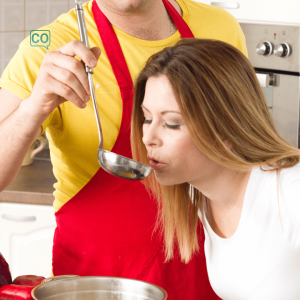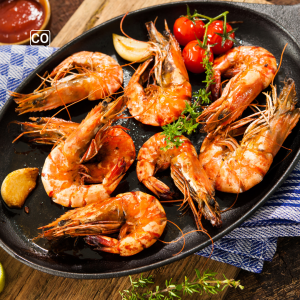Learn to order takeaway in Spanish using key expressions like "acabar de" (to have just), "empezar a" (to start to), and "volver a" (to do again). Practice with vocabulary such as "tortilla de patata" and "croquetas" to confidently request your favorite tapas and dishes.
Listening and reading
Start this class by listening to the audio and completing the corresponding exercises.
A2.24.2 Cultura
La tortilla de patata: ¿qué tiene de especial?
La tortilla de patata: what makes it special?
Vocabulary (20) Share Copied!
Exercises Share Copied!
These exercises can be done together during conversation lessons or as homework.
Exercise 1: Translate and use in a sentence
Instruction: Pick a word, translated and use the word in a sentence or dialogue.
1
Estar lleno
To be full
2
La comida rápida
The fast food
3
La pasta
Pasta
4
Las patatas bravas
Bravas potatoes
5
La ración
The portion
Ejercicio 2: Conversation exercise
Instrucción:
- Quieres pedir comida para llevar. ¿Qué dices? (You want to order takeaway. What do you say?)
- ¿Cocinas tú mismo o sueles pedir comida para llevar? ¿Por qué? (Do you cook yourself or do you often order takeaway? Why?)
- ¿Te gusta la comida rápida? ¿Y qué me dices de las comidas preparadas? (Do you like fastfood? And what about prepared meals?)
Teaching guidelines +/- 10 minutes
Example phrases:
|
¡Hola! Me gustaría pedir unas croquetas y también pasta con salsa de tomate, por favor. Hello! I would like to order some croquettes as well as some pasta with tomato sauce, please. |
|
¡Buenas noches! ¿Puedo pedir un Pad Thai, rollitos de primavera y arroz frito? Good evening! Can I please have a Pad Thai, Egg Rolls and Fried Rice? |
|
No me gusta cocinar. Por lo tanto, pido comida para llevar con bastante frecuencia. I don't like to cook. Therefore I order takeaway quite often. |
|
Es caro pedir comida para llevar todo el tiempo. Así que solo lo hago a veces. It is expensive ordering takeaway all the time. So I only do it sometimes. |
|
Prefiero cocinar yo mismo. Es más saludable y más barato. I prefer cooking myself. It is healthier and cheaper. |
|
No me gusta la comida rápida como las hamburguesas y las patatas fritas, pero me encanta la comida china. I don't like fastfood like burgers and fries but I do love chinese food. |
| ... |
Exercise 3: Dialogue Cards
Instruction: Select a situation and practice the conversation with your teacher or fellow students.
Exercise 4: Multiple Choice
Instruction: Choose the correct solution
1. Acabo de _____ una ración de gambas porque tengo hambre.
(I just _____ a portion of prawns because I am hungry.)2. Después de comer las tapas, empecé a _____ la tortilla de patata.
(After eating the tapas, I started to _____ the potato omelette.)3. Volví a _____ patatas bravas porque estaban deliciosas.
(I _____ patatas bravas again because they were delicious.)4. Cuando _____ tomar algo, el restaurante ya estaba cerrado.
(When I _____ to have something, the restaurant was already closed.)Exercise 5: A takeout dinner after work
Instruction:
Verb Tables
Querer - To want
Pretérito indefinido
- yo quise
- tú quisiste
- él/ella/usted quiso
- nosotros/nosotras quisimos
- vosotros/vosotras quisisteis
- ellos/ellas/ustedes quisieron
Empezar - To start
Pretérito indefinido
- yo empecé
- tú empezaste
- él/ella/usted empezó
- nosotros/nosotras empezamos
- vosotros/vosotras empezasteis
- ellos/ellas/ustedes empezaron
Pedir - To order
Pretérito indefinido
- yo pedí
- tú pediste
- él/ella/usted pidió
- nosotros/nosotras pedimos
- vosotros/vosotras pedisteis
- ellos/ellas/ustedes pidieron
Probar - To try
Pretérito indefinido
- yo probé
- tú probaste
- él/ella/usted probó
- nosotros/nosotras probamos
- vosotros/vosotras probasteis
- ellos/ellas/ustedes probaron
Volver - To return
Pretérito indefinido
- yo volví
- tú volviste
- él/ella/usted volvió
- nosotros/nosotras volvimos
- vosotros/vosotras volvisteis
- ellos/ellas/ustedes volvieron
Estar - To be
Pretérito imperfecto
- yo estaba
- tú estabas
- él/ella/usted estaba
- nosotros/nosotras estábamos
- vosotros/vosotras estabais
- ellos/ellas/ustedes estaban
Exercise 6: "Acabar de", "empezar a" , "volver a" + infinitivo
Instruction: Fill in the correct word.
Grammar: "Acabar de", "empezar a", "volver a" + infinitive
Show translation Show answersempiezan a, acaban de, empecé a, vuelve a, acabamos de, acabas de
Grammar Share Copied!
It's not the most exciting thing, we admit, but it’s absolutely essential (and we promise it'll pay off)!
A2.24.3 Gramática
"Acabar de", "empezar a" , "volver a" + infinitivo
"Acabar de", "empezar a", "volver a" + infinitive
Verb conjugation tables for this lesson Share Copied!
Pedir to ask Share Copied!
Pretérito indefinido
| Spanish | English |
|---|---|
| (yo) pedí | I asked |
| (tú) pediste | You asked |
| (él/ella) pidió | he/she asked |
| (nosotros/nosotras) pedimos | we asked |
| (vosotros/vosotras) pedisteis | you asked |
| (ellos/ellas) pidieron | they asked |
Querer to want Share Copied!
Pretérito indefinido
| Spanish | English |
|---|---|
| (yo) quise | I wanted |
| (tú) quisiste | You wanted |
| (él/ella) quiso | he/she wanted |
| (nosotros/nosotras) quisimos | we wanted |
| (vosotros/vosotras) quisisteis | You wanted |
| (ellos/ellas) quisieron | they wanted |
Probar to try Share Copied!
Pretérito indefinido
| Spanish | English |
|---|---|
| (yo) probé | I tried |
| (tú) probaste | You tried |
| (él/ella) probó | he/she tried |
| (nosotros/nosotras) probamos | we tried |
| (vosotros/vosotras) probasteis | You tried |
| (ellos/ellas) probaron | they tried |
Don't see progress when learning on your own? Study this material with a certified teacher!
Do you want to practice Spanish today? That is possible! Just contact one of our teachers today.
Takeaway Food in Spanish: Lesson Overview
This lesson focuses on ordering takeaway food in Spanish, introducing essential vocabulary and useful expressions for everyday situations at local eateries. You will learn how to communicate when ordering takeaway tapas, menu items like tortilla de patata, and how to use common Spanish verbs and phrases for ordering and confirming food to go.
Key Language Points
- Vocabulary for popular Spanish takeaway dishes: tapas, tortilla de patata, croquetas, calamares, patatas bravas, paella, ensalada, tacos.
- Important verbal expressions and periphrasis: acabar de (to have just done something), empezar a (to start doing something), and volver a (to do something again) + infinitive. These expressions are essential in discussing recent actions and repeated behaviors, especially useful when placing orders.
- Ordering and confirming takeaway orders: Phrases like "¿Qué menús para llevar tienen hoy?" (What takeaway menus do you have today?), "¿Quieres algo más?" (Do you want anything else?), and "Tu pedido estará listo en diez minutos" (Your order will be ready in ten minutes) help you handle real-life ordering situations with confidence.
Practical Example Expressions
- Acabo de llegar a casa y necesito comer rápido. (I just got home and need to eat quickly.)
- Voy a volver a pedir la tortilla que probé la semana pasada. (I'm going to order again the tortilla I tried last week.)
- Empecé a probar las croquetas ayer y quiero otra ración. (I started trying the croquettes yesterday and want another portion.)
Differences and Useful Notes
In English, expressing recent actions typically uses the present perfect (

































